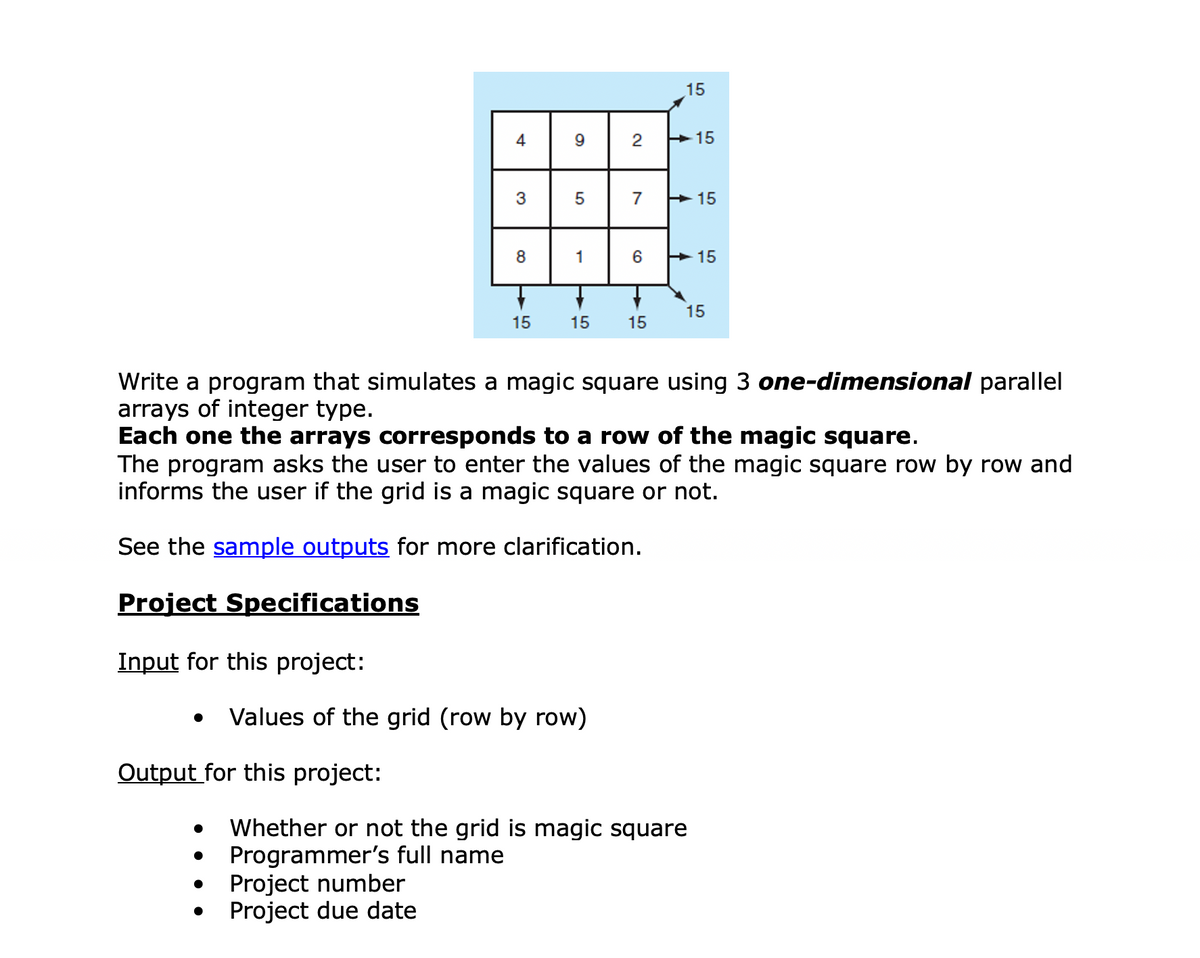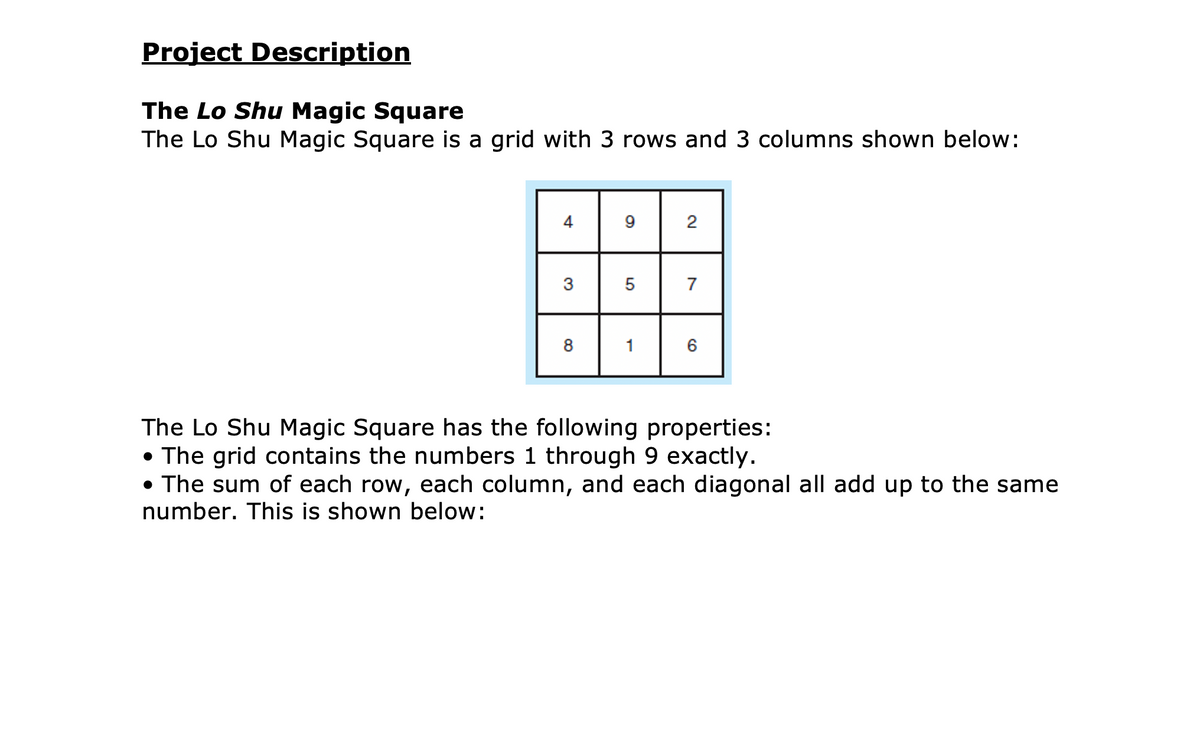nput for this project: Values of the grid (row by row) Output for this project: Whether or not the grid is magic square Programmer’s full name Project number Project due date Processing Requirements Start from scratch. Use the following template to start your project: #include using namespace std; // Global constants const int ROWS = 3; // The number of rows in the array const int COLS = 3; // The number of columns in the array const int MIN = 1; // The value of the smallest number const int MAX = 9; // The value of the largest number // Function prototypes bool isMagicSquare(int arrayRow1[], int arrayRow2[], int arrayRow3[], int size); bool checkRange(int arrayRow1[], int arrayRow2[], int arrayRow3[], int size, int min, int max); bool checkUnique(int arrayRow1[], int arrayRow2[], int arrayRow3[], int size); bool checkRowSum(int arrayrow1[], int arrayrow2[], int arrayrow3[], int size); bool checkColSum(int arrayrow1[], int arrayrow2[], int arrayrow3[], int size); bool checkDiagSum(int arrayrow1[], int arrayrow2[], int arrayrow3[], int size); void fillArray(int arrayRow1[], int arrayRow2[], int arrayRow3[], int size); void showArray(int arrayrow1[], int arrayrow2[], int arrayrow3[], int size); int main() { /* Define a Lo Shu Magic Square using 3 parallel arrays corresponding to each row of the grid */ int magicArrayRow1[COLS], magicArrayRow2[COLS], magicArrayRow3[COLS]; // Your code goes here return 0; } // Function definitions go here Do not repeat any source code segment you submitted in previous semesters. Create and use at least the following functions: void fillArray(int arrayrow1[], int arrayrow2[], int arrayrow3[], int size) - Accepts 3 int arrays and a size as arguments, and fills the arrays out with values entered by the user. First argument corresponds to the first row of the magic square, second argument to the second row and the third argument to the third row of the magic square void showArray(int arrayRow1[], int arrayRow2[], int arrayRow3[], int size) - accepts 3 int arrays and a size as arguments and displays their content. Example: 1 3 5 (arrayRow1) 6 7 9 (arrayRow2) 8 2 4 (arrayRow3) bool isMagicSquare(int arrayRow1[], int arrayRow2[], int arrayRow3[], int size) - accepts 3 int arrays and a size as arguments and returns true if all the requirements of a magic square are met. Otherwise, it returns false. First argument corresponds to the first row of the magic square, second argument to the second row and the third argument to the third row of the magic square. bool checkRange(int arrayRow1[], int arrayRow2[], int arrayRow3[], int size, int min, int max) - accepts 3 int arrays, a size and a min and max value as arguments and returns true if the values in the arrays are within the specified range min and max. Otherwise, it returns false. First argument corresponds to the first row of the magic square, second argument to the second row and the third argument to the third row of the magic square. bool checkUnique(int arrayRow1[], int arrayRow2[], int arrayRow3[], int size) - accepts 3 int arrays and a size as arguments, and returns true if the values in the arrays are unique (only one occurrence of numbers between 1-9). Otherwise, it returns false. First argument corresponds to the first row of the magic square, second argument to the second row and the third argument to the third row of the magic square. bool checkRowSum(int arrayRow1[], int arrayRow2[], int arrayRow3[], int size) - accepts 3 int arrays and a size as arguments and returns true if the sum of the values in each of the rows are equal. Otherwise, it returns false. First argument corresponds to the first row of the magic square, second argument to the second row and the third argument to the third row of the magic square. bool checkColSum(int arrayRow1[], int arrayRow2[], int arrayRow3[], int size) - accepts 3 int arrays and a size as arguments and returns true if the sum of the values in each of the columns are equal. Otherwise, it returns false. First argument corresponds to the first row of the magic square, second argument to the second row and the third argument to the third row of the magic square. bool checkDiagSum(int arrayrow1[], int arrayrow2[], int arrayrow3[], int size) - accepts 3 int arrays and a size as arguments and returns true if the sum of the values in each of the array's diagonals are equal. Otherwise, it returns false. First argument corresponds to the first row of the magic square, second argument to the second row and the third argument to the third row of the magic square. [NOTE: You can create and use more functions as needed.] Test Plan Test your program with at least 3 more test cases. Use the given data as an example. Record your data for input and output in the following table. Make sure your tests cover all the possible scenarios in the scope of concepts described in Chapters mentioned above.
C++
Project Description
Project Specifications
Input for this project:
- Values of the grid (row by row)
Output for this project:
- Whether or not the grid is magic square
- Programmer’s full name
- Project number
- Project due date
Processing Requirements
Start from scratch.
Use the following template to start your project:
#include<iostream>
using namespace std;
// Global constants
const int ROWS = 3; // The number of rows in the array
const int COLS = 3; // The number of columns in the array
const int MIN = 1; // The value of the smallest number
const int MAX = 9; // The value of the largest number
// Function prototypes
bool isMagicSquare(int arrayRow1[], int arrayRow2[], int arrayRow3[], int size);
bool checkRange(int arrayRow1[], int arrayRow2[], int arrayRow3[], int size, int min, int max);
bool checkUnique(int arrayRow1[], int arrayRow2[], int arrayRow3[], int size);
bool checkRowSum(int arrayrow1[], int arrayrow2[], int arrayrow3[], int size);
bool checkColSum(int arrayrow1[], int arrayrow2[], int arrayrow3[], int size);
bool checkDiagSum(int arrayrow1[], int arrayrow2[], int arrayrow3[], int size);
void fillArray(int arrayRow1[], int arrayRow2[], int arrayRow3[], int size);
void showArray(int arrayrow1[], int arrayrow2[], int arrayrow3[], int size);
int main()
{
/* Define a Lo Shu Magic Square using 3 parallel arrays corresponding to each row of the grid */
int magicArrayRow1[COLS], magicArrayRow2[COLS], magicArrayRow3[COLS];
// Your code goes here
return 0;
}
// Function definitions go here
Do not repeat any source code segment you submitted in previous semesters.
Create and use at least the following functions:
- void fillArray(int arrayrow1[], int arrayrow2[], int arrayrow3[], int size) - Accepts 3 int arrays and a size as arguments, and fills the arrays out with values entered by the user. First argument corresponds to the first row of the magic square, second argument to the second row and the third argument to the third row of the magic square
- void showArray(int arrayRow1[], int arrayRow2[], int arrayRow3[], int size) - accepts 3 int arrays and a size as arguments and displays their content.
Example:
1 3 5 (arrayRow1)
6 7 9 (arrayRow2)
8 2 4 (arrayRow3)
- bool isMagicSquare(int arrayRow1[], int arrayRow2[], int arrayRow3[], int size) - accepts 3 int arrays and a size as arguments and returns true if all the requirements of a magic square are met. Otherwise, it returns false. First argument corresponds to the first row of the magic square, second argument to the second row and the third argument to the third row of the magic square.
- bool checkRange(int arrayRow1[], int arrayRow2[], int arrayRow3[], int size, int min, int max) - accepts 3 int arrays, a size and a min and max value as arguments and returns true if the values in the arrays are within the specified range min and max. Otherwise, it returns false. First argument corresponds to the first row of the magic square, second argument to the second row and the third argument to the third row of the magic square.
- bool checkUnique(int arrayRow1[], int arrayRow2[], int arrayRow3[], int size) - accepts 3 int arrays and a size as arguments, and returns true if the values in the arrays are unique (only one occurrence of numbers between 1-9). Otherwise, it returns false. First argument corresponds to the first row of the magic square, second argument to the second row and the third argument to the third row of the magic square.
- bool checkRowSum(int arrayRow1[], int arrayRow2[], int arrayRow3[], int size) - accepts 3 int arrays and a size as arguments and returns true if the sum of the values in each of the rows are equal. Otherwise, it returns false. First argument corresponds to the first row of the magic square, second argument to the second row and the third argument to the third row of the magic square.
- bool checkColSum(int arrayRow1[], int arrayRow2[], int arrayRow3[], int size) - accepts 3 int arrays and a size as arguments and returns true if the sum of the values in each of the columns are equal. Otherwise, it returns false. First argument corresponds to the first row of the magic square, second argument to the second row and the third argument to the third row of the magic square.
- bool checkDiagSum(int arrayrow1[], int arrayrow2[], int arrayrow3[], int size) - accepts 3 int arrays and a size as arguments and returns true if the sum of the values in each of the array's diagonals are equal. Otherwise, it returns false. First argument corresponds to the first row of the magic square, second argument to the second row and the third argument to the third row of the magic square.
[NOTE: You can create and use more functions as needed.]
Test Plan
Test your program with at least 3 more test cases. Use the given data as an example. Record your data for input and output in the following table. Make sure your tests cover all the possible scenarios in the scope of concepts described in Chapters mentioned above.


Trending now
This is a popular solution!
Step by step
Solved in 5 steps with 1 images






